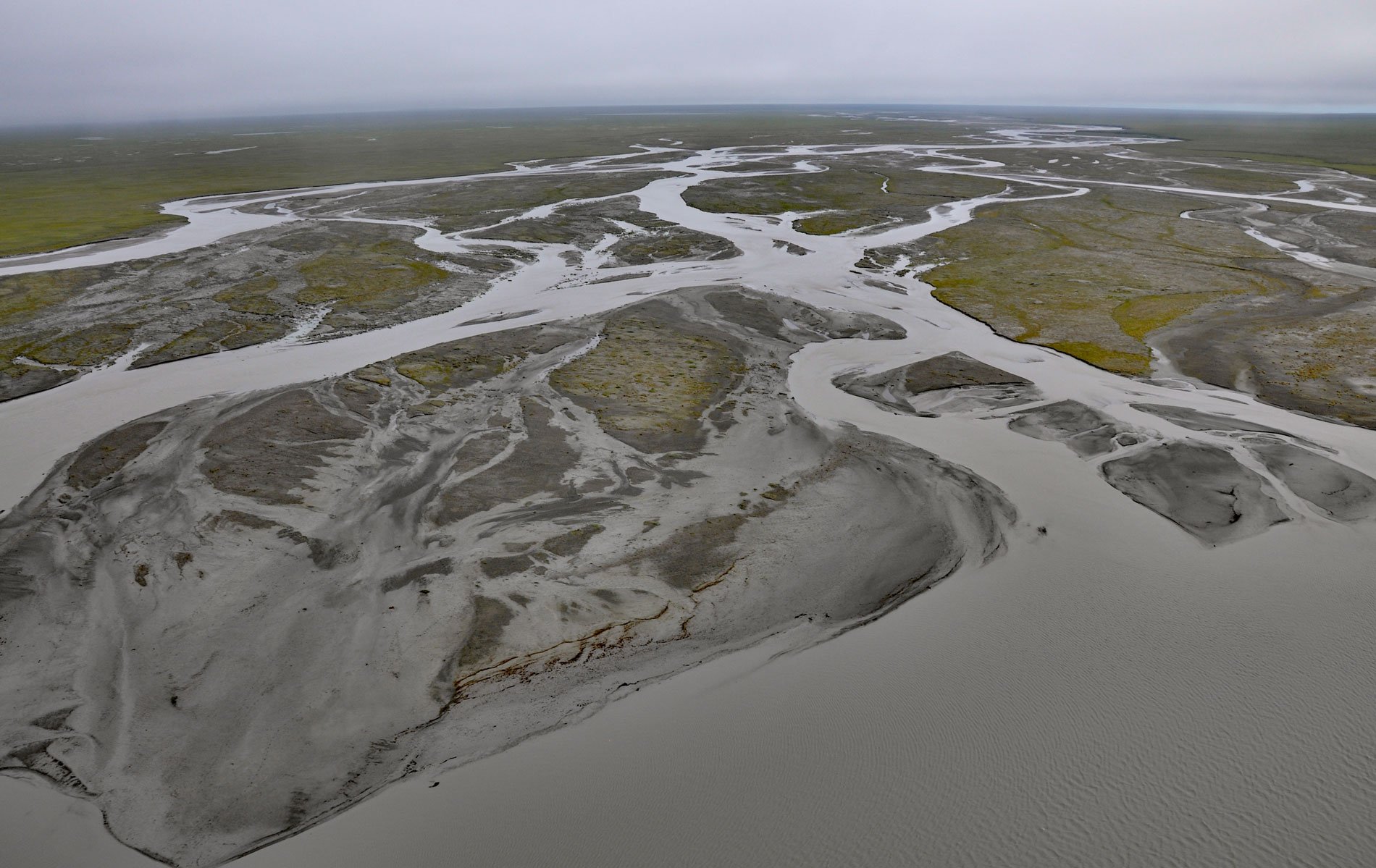Jago River starts at an unnamed glacier on the continental divide of the Romanzof Mountains in the Brooks Range and flows north for about 90 miles (145 km) through the Arctic National Wildlife Refuge to Jago Lagoon, about 88 miles (142 km) east-northeast of Deadhorse and 7 miles (11 km) east-southeast of Kaktovik, Alaska. The Brooks Range extends for 700 miles (1,100 km) from west to east across northern Alaska into Canada’s Yukon Territory. The range was named by the U.S. Board on Geographic Names in 1925 after Alfred Hulse Brooks of the U.S. Geological Survey, who was chief geologist for Alaska from 1903 to 1924. The Romanzof Mountains extend for 65 miles (105 km) between the Hulahula and Kongakut Rivers in the Brooks Range. These mountains were named by Sir John Franklin on August 3, 1826 for Count Nicholas Romanzof, Chancellor of the Russian Empire. The Jago River was named by Ernest de Koven Leffingwell in 1919, who modified the local name “Jags” to “Jago” to honor Lieutenant Charles Jago, a crew member in 1851-1855 of Captain Richard Collinson‘s ship HMS Enterprise that was sent in search of the lost Franklin Expedition. On his way into the Arctic via Bering Strait in 1851, Captain Collinson bought three dogs from the Yup’ik Eskimos in the vicinity of the Bering Strait. Charles Jago also purchased a team from the Inuit of the Walker Bay area of western Victoria Island. Enterprise spent three successive winters locked in sea ice and the crew used the opportunity to explore the Arctic coast with small boats and dog sleds. The final winter was spent in Camden Bay in the Beaufort Sea and in April 1854, several sledding and boat forays were made to explore the Arctic coast of northwestern Alaska including the Jago River and Barter Island.
Barter Island is about 8 miles (13 km) northwest of the Jago River mouth and was a major trade center for the Iñupiat people from Alaska and Inuit from Canada in the 1800s. In about 1900, a large whaling village was located on Barter Island. In about 1919, trader Tom Gordon and his family moved from Barrow to Barter Island and built a trading post and other families soon settled nearby. In 1947, the U.S. military built a runway on Barter Island, and in 1953 this was extended to support a Distant Early Warning Line radar station colocated with a White Alice communication station that operated until 1990 when technological advances allowed for more automation. Several families settled near the facility and the community of Kaktovik was organized in 1971. In 1990, the Barter Island DEW Line station was deactivated and replaced with a Long Range Radar Station. Since the Cold War, tens of thousands of steel drums have littered Barter Island and the surrounding coastal plain. The drums once contained petroleum, oil, and lubricant products for the radar station. Over a thousand drums were found in the Jago River delta, many originating from Manning Point, an island adjacent to Barter Island. Locals in Kaktovik refer to Manning Point as “Drum Island” where an estimated 30,000 to 50,000 drums were abandoned by the military and then redistributed by high winds. In 2010, a Jago River cleanup was funded by the Defense Environmental Restoration Program, the agency responsible for environmental contamination released from historic military facilities.
In 1929, Bob Marshall was working on a Ph.D. in plant physiology at Johns Hopkins University when he made his first trip to Alaska, visiting the upper Koyukuk River and the central Brooks Range. The scientific objective of the trip was to study tree growth at the northern timberline near the Arctic Divide and he stayed for 15 months in a one-room cabin in Wiseman. Marshall was one of the first to explore the Brooks Range, especially the headwaters of the north fork of the Koyukuk River where he named a pair of prominent mountains the “Gates of the Arctic“. In 1935, he was instrumental in founding The Wilderness Society. In 1954, the National Park Service recommended that the untouched northeastern region of Alaska be preserved for research and the protection of nature. In 1956, Olaus and Margaret Murie of the Wilderness Society led an expedition to the Brooks Range where they dedicated an entire summer to studying the land and wildlife ecosystems of the upper Sheenjek River Valley. The conclusion of these studies was the importance of preserving the area intact, a determination that would play an instrumental role in designating the area as a federally protected wilderness. In 1960, the Secretary of the Interior established the Arctic Range of 9 million acres (3,642,174 ha). In 1980, the Alaska National Interest Lands Conservation Act more than doubled the Arctic Range and renamed it the Arctic National Wildlife Refuge. In Section 1002 of that act, the U.S. Congress deferred a decision regarding future management of the 1.5 million acres (607,029 ha) of the coastal plain, which includes the Jago River delta, in recognition of the area’s potentially enormous oil and gas resources and its importance as wildlife habitat. Oil drilling in the “1002 area” of the refuge has been an ongoing political controversy. Much of the debate rests on the amount of economically recoverable oil, as it relates to world oil markets, weighed against the potential harm oil exploration might have upon the natural wildlife, in particular the calving ground of the Porcupine caribou herd. Read more here and here. Explore more of the Jago River and the Arctic National Wildlife Refuge here:

